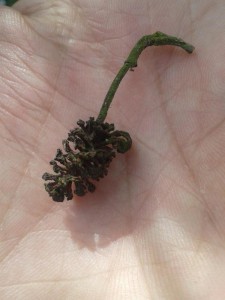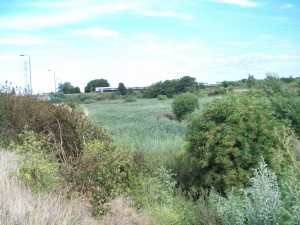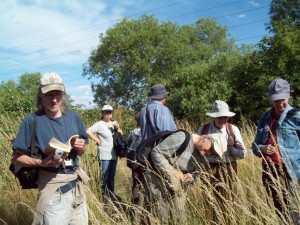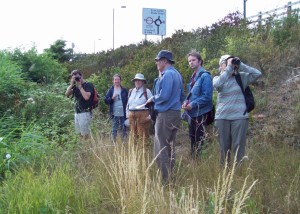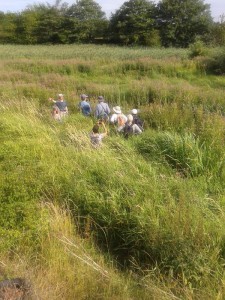Seven members of the Quaggy Waterways Action Group, a river restoration organisation, and the Secretary of Friends of Sutcliffe Park, all from Lewisham, visited Thames Road Wetland on Saturday July 18th to learn more about the possibilities for enhancing wetland in their own area.
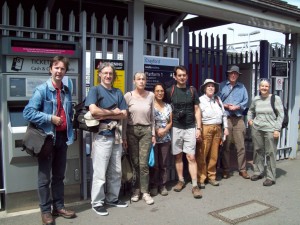
After problems with engineering works, the group finally assembles at Crayford railway station, ready for the off.
At first it looked as if we might never get to the site as QWAG members took an unexpectedly intense interest in the new buildings and sculpture around the old Crayford Town Hall, metal drain covers and soakaways. Meanwhile, I’m told, a PCSO was casting a suspicious eye over the shears protruding from my bag. We eventually made it to Riverside Gardens, where children were playing in the river, oblivious to the problem of the Himalayan Balsam that was much in evidence by the main road bridge. The extent of the Balsam problem became even more obvious as we made our way down Footpath 106 towards Barnes Cray. A stop was made to look at the Bryony Ladybird site that is the fence of the Thames21 yard, and a single adult was found. Participants were also impressed by the Deadly Nightshade with its maroon flowers.
At Maiden Lane the proximity of the Cray to the Wansunt was pointed out, along with the fact that the former would now be getting ever higher above the floodplain in the artificially raised channel that delivers the drop over the sluice that powered the mill by Thames Road. Julia had a brief glimpse of a Kingfisher on the Wansunt, but unfortunately it didn’t come back to pose for the crowd.
The soaring, statuesque, other-wordly stands of the alien invasive Giant Hogweed by By-way 105 were ‘admired’ and discussed, and both Blue Tit and Long-tailed Tit were spotted feeding on insects within the flowerheads. The differences with native Hogweed and the ability of the two to hybridise were noted.
An Alder Tongue Gall was found along the by-way again, and QWAG members were encouraged to look out for this London rarity in their own area.
‘Dancing’ Banded Demoiselles along the Cray began to attract attention as we neared the wetland, and plants of the uncommon London species Dittander were pointed out.
Stopping at the junction of the by-way and Thames Road, the group was reminded of the history of the site, its design features and natural history, using printed aerial photographs.
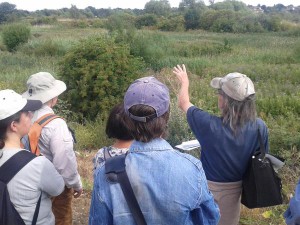
Site Manager Chris Rose reminds attendees of some of the key features of the site covered in his talk to QWAG last year. (Photo: Paul de Zylva)
We then went back to the sewer Pipe embankment for views over the lake, and the Wansunt going under the pipe bridge. The stolen scooter and motorbike in the river illustrated the challenges of championing nature in an urban environment. These will be removed by volunteers this coming week.
Then it was into the bowl of the site, where the path along the west end had become near-impenetrable since my last visit nearly a month ago – not so much with regrowth within the path, but fringing vegetation getting ever taller and flopping over. It was at this point that the shears came out and I took the lead, re-opening the pathway as we went along. This enabled scrutiny of Mistletoe, Square-stemmed St. John’s-wort and Hop Sedge, as well as the benefits to plant growth of a constant source of moisture plus very warm weather!
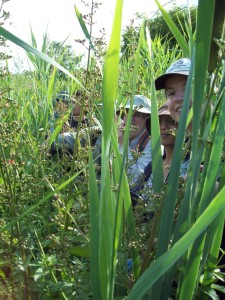
QWAG members enjoy the ‘back to nature’ experience in tall vegetation at the west end of the site. (Photo: Pamela Zollicoffer)
Emerging onto more open ground, the contrast with wilting shrubs and bare soil on the steep Thames Road bank was stark. Here we discussed ‘succession’, the value of having some scrub out in the wetland area itself but the need to manage it, Sustainable Urban Drainage principles and the ability (or not) of plants to break down pollutants into biologically safe derivatives. Their inability to deal with plastics and polystyrene was noted in the litter trap at the surface water run-off pipe from Thames Road.
Next up were the mighty Marsh Sow-thistles, now coming into flower, which towered over the group. The fact that there isn’t the right habitat change dynamic for them to reproduce was talked about.
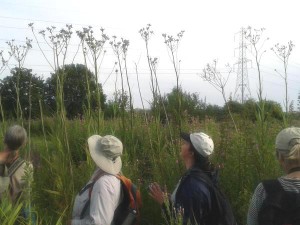
The QWAG team admire the towering Marsh Sow-thistles, a nationally scarce plant. (Photo: Paul de Sylva)
Up on the bone dry Thames Road ‘flat’ A pair of 6-spot Burnet Moths were copulating, and there were three plants of the chalk-loving Ploughman’s Spikenard in flower.
After climbing over the fence a couple of times to get to the east end without going over some barbed wire, the ditch arrangement and water feed to the site was looked at, along with the source of much of the site’s water, the Wansunt. The rare little Brookweed was shown to the visitors and the value of horse grazing and trampling pointed out.
Eagle-eyed Paul de Zylva spotted and photographed a Marsh Frog on the opposite side of the east ditch, which is hard to do as they usually jump into the water and stay submerged a long time once disturbed.
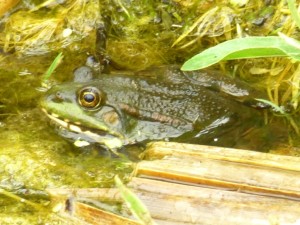
Marsh Frog in the east ditch at Thames Road Wetland. This species was introduced to the UK in the mid nineteen thirties in the Romney Marsh area and has spread widely since. (Photo: Paul de Zylva)
Our friends from Lewisham were then escorted to nearby bus stops to make their way home before I went back to the site for an hour or so, and was lucky enough to find a juvenile Grass Snake.
The visit was much enjoyed by those who came, and here are some of the comments received subsequently.
Pamela Zollicoffer said:
‘What was particularly nice about visiting the wetland is that, as well as being able to look at the plants and wildlife, we were very fortunate to have someone who could explain what we could see in such fine detail, someone who likes to tell us what it is and did not mind. This makes it so much more enjoyable and special.
It is an experience to just walk through the reeds, to smell them and feel them as they brush against you, sensing their vertical height above you, not being sure where you are going and if you will ever find your way out. You feel you are lost in the jungle and are in a real-life adventure movie.’
Julia Grollman commented:
‘So much to learn… many thanks for sharing your naturalist’s world so comprehensively.’
Paul de Zylva said:
‘Thanks so much for taking us QWAG-ers on a fabulous trip to and through the Thames Road Wetland on Saturday 18 July. What a venture – from suburban and often scrubbly hinterland to working through the reeds to the depths of the wildlife haven – we had a great time getting to and being on the haven. It certainly proves that to see wildlife, you just have to look /listen as the traffic roars by. There are some shots on the QWAG twitter feed <http://www.twitter.com/qwag> so do look there for some pics -and a story of sorts of our journey – if you want. Excuse the typos.’
We are happy to give guided tours to other groups and individuals. Contact Site Manager Chris Rose chrisrose@gn.apc.org
Chris Rose, Thames Road Wetland Site Manager.

